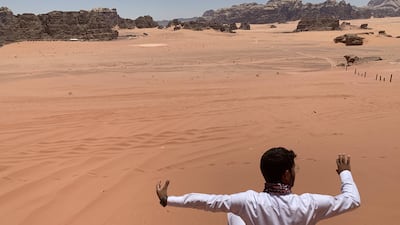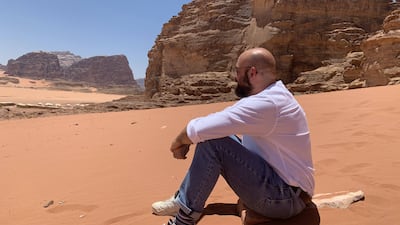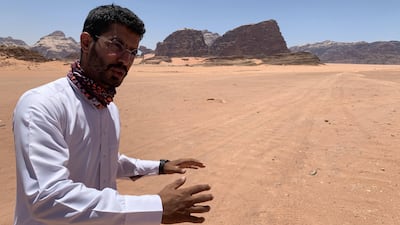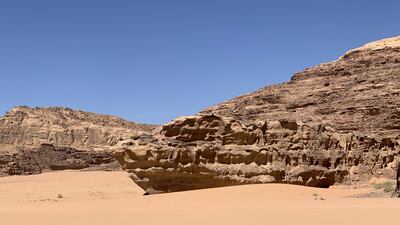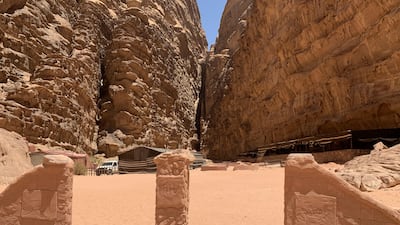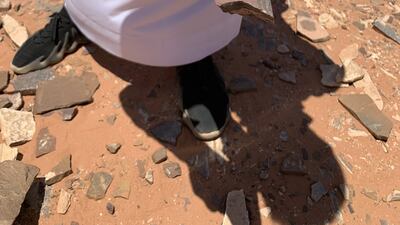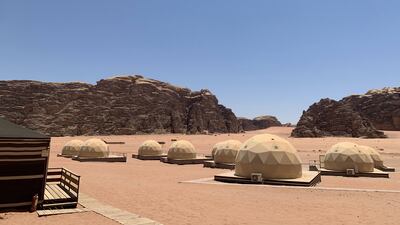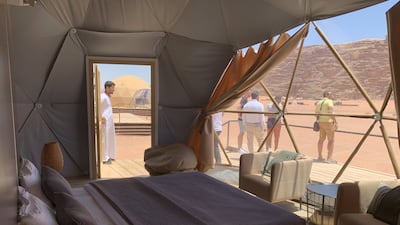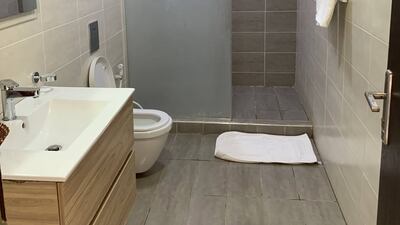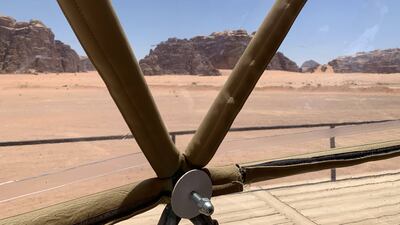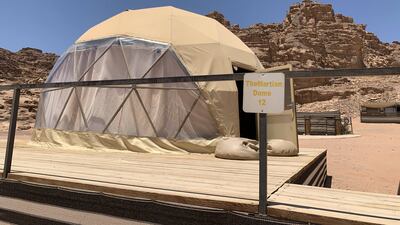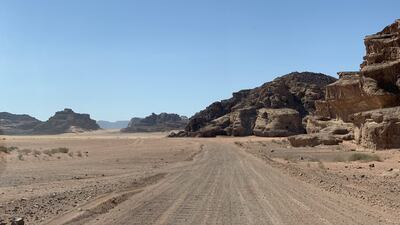With its ochre vastness and dramatic sandstone heights, Jordan's Wadi Rum, also known as the Valley of the Moon, has long been a favourite among Hollywood filmmakers scouting for otherworldly vistas.
The desert has doubled for Mars in several blockbusters including The Martian and Red Planet. It has been the site for fictional desert planets in films from the Star Wars franchise and Dune.
This is where Rey confronted Kylo Ren, where Paul Atreides had his fevered visions, and where Dr Mark Watney grew Martian potatoes. It is also where Aladdin found the Cave of Wonders and befriended the Genie. And this is just the tip of the iceberg, a few cracks on the cliff face or a palmful of sand from a dune — whichever the topographic-specific metaphor fits best here.
In other words, it’s hard to find a desert on this side of the globe with a more expansive cinematic history than Wadi Rum.
“There are some 600 projects that are filmed here every year,” says Bashar Abu Nuwar, a senior coordinator at the Royal Film Commission. “This includes advertisements, music videos, short films, as well as feature-length works.”
“The most recent big works filmed here were Dune and Mohamed Diab’s Moon Knight series,” he says. “There was also the still-unreleased Korean blockbuster The Negotiation that was the first film to be shot here after the pandemic. The cast and crew were here for a month in the summer of 2020 and shot in 16 locations across Jordan, including Wadi Rum.”
Other notable films that have been shot in the area include the 2009 Michael Bay blockbuster Transformers: Revenge of the Fallen and the 2017 Ridley Scott thriller All The Money in the World. In those films, however, Wadi Rum doubled as deserts from neighbouring Middle Eastern countries.
One film that makes use of Wadi Rum’s photogenic aspects while incorporating the landscape in its plot is Naji Abu Nowar’s Oscar-nominated film Theeb. The coming-of-age drama from 2014 is set during the First World War and features a cast made up largely of Bedouins from the area, with no previous acting experience.
The film that started it all, however, and introduced this spectacular landscape to the wider world, is the 1962 epic Lawrence of Arabia.
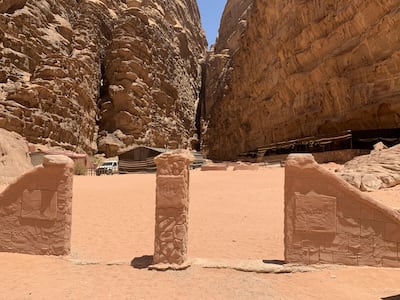
This is fitting, considering this is historically where the events of the film actually took place.
There are several locations that stand as a testament to the 1917 Arab revolt against the Ottoman Empire. One of them is a canyon that served as the base of operations for British explorer and army officer Thomas Edward Lawrence, Emir Auda Abu Tayeh and Abdullah I bin al-Husayn, who would go on to become the first king of Jordan. The canyon's shade provided cool breeze during sweltering summer months and was strategically advantageous as it amplified surrounding sounds and alerted the base of incoming forces.
Another of Wadi Rum’s most popular hiking trails also alludes to the British explorer. The Seven Pillars of Wisdom is a rock formation located in the Wadi Rum World Reserve and is a Unesco World Heritage site. It inspired the name of Lawrence’s autobiographical account of the revolt — the title is drawn from the third section of the Book of Proverbs.
There are other sites that also pay homage to Lawrence and the revolt, including Lawrence’s House, which is where the British personality is rumoured to have stayed during his time in the desert. Local Bedouins call the site The Small Palace.

Wadi Rum’s historical significance, however, stretches back much, much further. Seashells can be found across the desert as testament to the site being underwater millions of years ago. Archaeological findings suggest the area has been inhabited since as early as 4500 BC.
The area is believed to have been settled by the Nabateans even before Petra. An ancient Thamudic temple at the foot of Jabal Rum, the mountains that lend their name to the wadi, was renovated about 2,000 years ago by the ancient civilisation. Nabatean inscriptions, some of which date back to 350 BC, are carved on the sandstones — the petroglyphs guided travellers as they crossed the harsh desert.
The desert’s contemporaries are just as fascinating.
Much of Jordan’s produce can be traced to the agricultural efforts of Wadi Rum’s local population. Besides agriculture, the Bedouins here have also found a dependable source of income from the filmmaking industry, helping cinematographers scout for picturesque locations or to give them insight into the desert’s idiosyncrasies.
One such person is Yanal Abdulaziz Al Zawaidah, who has been involved in Wadi Rum’s filmmaking scene since Red Planet. The 2000 science-fiction film, which stars Val Kilmer and Carrie-Ann Moss, may have been a critical and commercial bomb, but it instilled in Al Zawaidah a lifelong fascination for the filmmaking process.
“I was little, about 5 years old,” he says. “I went with my father to help cordon off the filming area to prevent people and cars from crossing the area and interrupting the shooting process. I’ve been involved in films ever since. I grew up in the film world.
“Even today, we enrol in workshops offered by the Royal Film Commission, from production to scriptwriting,” he says. “It familiarises us with the filmmaking process.”
Al Zawaidah is one of the people who international production companies task to guide them across deserts, scouting for film locations. He drives us along a dirt track that has been colloquially named Disney Road, as it has been used by the mega-corporation to bring in filming equipment for projects including Aladdin, Rogue One: A Star Wars Story, as well as Star Wars: The Rise of Skywalker, all projects that Al Zawaidah has been involved in. Along the way, he points out to towering rock formations that are named by the locals according to what they are visually reminiscent of.

There is the Titanic, which is shaped like a boat, and The Face, which has contours resembling a nose and lips. He then takes us to the rock arches featured in the 2019 live-action remake of Aladdin, as well as the large rocky hill, from which a 20-metre-high green screen was hung for the Cave of Wonders.
When asked whether he has photos of what must have been a spectacular sight, Al Zawaidah says that the cast and crew are usually forbidden to take shots during production, to avoid leaks. It is a rule that Al Zawaidah says he and other locals working in the film sector take seriously.
“We never take any pictures or videos,” he says. “We’ve experienced many memorable moments during film productions, and we’re happy to simply recollect them."
Al Zawaidah has a unique understanding of Wadi Rum’s topography, even when compared to his Bedouin compatriots. As we drive across its flatlands and dunes, he points at lone shrubs and greenery, elaborating on their individual properties and how they are used to treat burns and wounds. He also explains how, before water reservoirs were installed, local Bedouins sourced water, finding recesses in the sandstones, which rainfall had filled, and drinking the water through a gauze filter. He points to the varying colours of the sand, from an alabaster white, which kick up in dust clouds as vehicles drive across, to a deep red.
“Whenever I want to be by myself, I head out to the red patches,” he says. “Those areas are heavy with iron and can really help get rid of negative energy. But to tell you the truth, I don’t have a favourite spot. Each area has its own purpose, its own allure. The city you live in, you learn its every landmark and meter, don’t you? It’s the same for us. I can identify these areas even at night.”
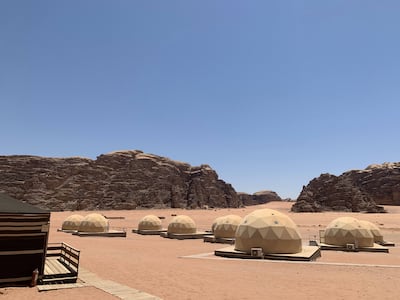
Besides its appeal among film professionals, Wadi Rum is also a popular tourist destination, particularly for those looking to indulge in a pseudo-Martian vacation.
Several luxury camps have popped up in the areas outside the protected jurisdictions. One such property is Sun City Camp, which features large bubble-like tents that are built, Royal Film Commission's Abu Nuwar says, by the same German company that oversaw the set of The Martian.
Each tent is air-conditioned and equipped with a queen-sized bed, spacious bathroom and breathtaking views of the surrounding desert. Most impressive is the plastic film that makes up its floor to bubble-top windows. The plastic is cool to the touch, despite being subject to direct sunlight all day. Tents average at $150 a night, depending on seasonal rates.
The camp’s visitors can also dig into a traditional Bedouin barbecue, or zarb. The ancient technique involves cooking meat, chicken, vegetables and rice on metal racks that are blanketed in foil and buried in sand. The food is roasted slowly in the coal-filled pit over the course of several hours. The meat, chicken, carrots and potatoes come out with a crunchy exterior, but a tender, juicy interior.
“It’ll do no good explaining it,” Al Zawaidah says. “You have to taste it to really know how unique it is.”
As breathtaking as Wadi Rum is during the day, it is even more spectacular at night, Al Zawaidah says.
“The four biggest telescopes in the Middle East are here,” he says. “But even without them, you can see details with the naked eye that are humbling.”
Al Zawaidah advises all those looking to come to Wadi Rum to seek out a Bedouin guide to decipher the language and history of the desert, as well as to experience, first-hand, the hospitable nature of Wadi Rum’s locals.
“This is our house, and we don’t want people to take the wrong idea about their house."
